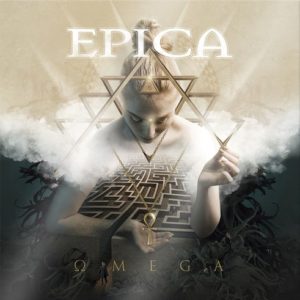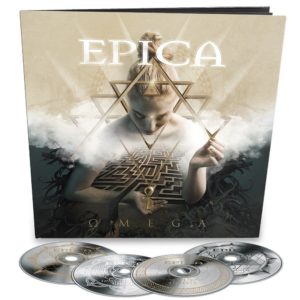
Epica «Omega» (2021): From Alpha to Omega
 This review needs to start with one single word: epic! Because it is dedicated to the release of the new album «Omega» of the Dutch symphonic metallers Epica. In fact, this Dutch sextet is one of the founders of symphonic metal. In an interview, the musicians say that Epica is a place in the Universe where you can find answers to all pressing questions. And each of the albums is dedicated to a particular idea or problem, whether it can be new discoveries in the field of quantum physics, allusions to Zen Buddhism in its European understanding, or the theory of the holographic principle.
This review needs to start with one single word: epic! Because it is dedicated to the release of the new album «Omega» of the Dutch symphonic metallers Epica. In fact, this Dutch sextet is one of the founders of symphonic metal. In an interview, the musicians say that Epica is a place in the Universe where you can find answers to all pressing questions. And each of the albums is dedicated to a particular idea or problem, whether it can be new discoveries in the field of quantum physics, allusions to Zen Buddhism in its European understanding, or the theory of the holographic principle.
And the release of The Flying Dutchman in 2021 refers us to the concept of the «Omega Point» proposed by the French theologian, Jesuit priest Pierre Teilhard de Chardin. The main conclusion of his philosophical research is as follows: «the Omega point» is a state of the most organized complexity and, at the same time, the highest consciousness, to which, in his opinion, the Universe is evolving. That is, in other words, we are all destined to go a long way – from the Big Bang to a single point of divine unity.
 Dutch symphonic metallers have outdone themselves again. Although Mark Jansen (rhythm guitarist, extreme vocalist and the «brain» of the band) says in an interview with «InRock» (it will be published in №93) that when recording «Omega» the band took a step back from their previous album, it is not certainly in that way. In «Omega» the stake is not placed on the simultaneously powerful sound of the orchestra, chorus and guitars or their competition on the principle of «who is stronger», but on building a general balance. In other words, in some moments the orchestra and the choir are brought to the fore, in others – the voice of the frontwoman Simone Simons or a heavy guitar sound, and all these components work in an indivisible synthesis. The difference between «Omega» and the previous full-length studio album «The Holographic Principle» (2016) lies in the way the orchestra is recorded. On «The Holographic Principle» (2016), it was recorded in sections: a group of strings, then brass, then woodwinds.
Dutch symphonic metallers have outdone themselves again. Although Mark Jansen (rhythm guitarist, extreme vocalist and the «brain» of the band) says in an interview with «InRock» (it will be published in №93) that when recording «Omega» the band took a step back from their previous album, it is not certainly in that way. In «Omega» the stake is not placed on the simultaneously powerful sound of the orchestra, chorus and guitars or their competition on the principle of «who is stronger», but on building a general balance. In other words, in some moments the orchestra and the choir are brought to the fore, in others – the voice of the frontwoman Simone Simons or a heavy guitar sound, and all these components work in an indivisible synthesis. The difference between «Omega» and the previous full-length studio album «The Holographic Principle» (2016) lies in the way the orchestra is recorded. On «The Holographic Principle» (2016), it was recorded in sections: a group of strings, then brass, then woodwinds.  During the recording of «Omega», a different principle was chosen – the Prague Philharmonic Orchestra was recorded at once in its entirely, in one room. Thus, the sound has become even more natural, spacious and lively! This idea Epica was able to realize thanks to the financial pillow, sagaciously prepared for a rainy day. And they did not lose, as a pandemic suddenly burst out afterwards. The Stabilization Fund turned out to be very useful! Also, the cast of performers on «Omega» has expanded thanks to the inclusion of a children’s choir, which has brought its unique colors to the overall palette of timbres. The recordings of the choirs and the symphony orchestra were completed exactly on the eve of the first official lockdown in Europe. Like the previous two albums, «Omega» was recorded and produced by the band’s longtime metal friend Joost van den Broek (keyboardist famed for After Forever, Star One/Ayreon, Sun Caged – editor’s note).
During the recording of «Omega», a different principle was chosen – the Prague Philharmonic Orchestra was recorded at once in its entirely, in one room. Thus, the sound has become even more natural, spacious and lively! This idea Epica was able to realize thanks to the financial pillow, sagaciously prepared for a rainy day. And they did not lose, as a pandemic suddenly burst out afterwards. The Stabilization Fund turned out to be very useful! Also, the cast of performers on «Omega» has expanded thanks to the inclusion of a children’s choir, which has brought its unique colors to the overall palette of timbres. The recordings of the choirs and the symphony orchestra were completed exactly on the eve of the first official lockdown in Europe. Like the previous two albums, «Omega» was recorded and produced by the band’s longtime metal friend Joost van den Broek (keyboardist famed for After Forever, Star One/Ayreon, Sun Caged – editor’s note).
People need hope, new meanings, a powerful message – especially now, on the verge of tectonic changes in the way of life of the entire planet. We can safely say – with the release of «Omega» Epica fans got it all. This album, the eighth in the band’s studio discography, is the final installment of a «metaphysical trilogy» that includes «The Quantum Enigma» (2014) and «The Holographic Principle» (2016). Now Epica invites us to walk the path to self-knowledge through the labyrinth of life, at the end of which we will reach the «Omega point», the point of unity. This musical labyrinth consists of 12 compositions, among which there are no passing or random ones. Each is an independent journey from «alpha» to «omega» through the labyrinth of being, in which various life phenomena and ideas are explored with the help of musical means of expression. The title idea is the dualism of light and darkness, permeating absolutely everything around us. This contrast is clearly reflected in the cover of the album, once again created by Stefan Heilemann, who has worked on the artwork for Epica albums starting with «The Classical Conspiracy» (2009). Let’s take a closer look at this music album – from track to track.
1. «Alpha – Anteludium»
The album opens with a vocal-symphonic introduction, reminiscent of a soundtrack to one of the many Oscar-winning films. This music draws endless imaginary expanses in front of the listener’s eyes, it feels the true flight of the soul towards the dawn of a new life!
 2. «Abyss of Time – Countdown to Singularity»
2. «Abyss of Time – Countdown to Singularity»
The next composition touches on such a thing as a singularity. The well-known stylistic device «beauty and the beast» is most clearly manifested in it, and it also manifests itself in the appearance of Mark and Simone in the video for this song. Also, in one of the episodes of the song, the melody that sounded earlier in the overture to the album «shines through».
3. «The Skeleton Key»
In this track, the contrast between light and darkness is especially exposed, but more attention is paid to the «darkened world». In this regard, I recall the essay of the compatriot of musicians, the Dutch historian and culturologist Johan Huizinga, one of whose works is called «The Darkened World». Judging by the video published on the channel of the «Nuclear Blast» label in YouTube on the day of the album’s release, another line emerges – the line of Jung’s archetypes, as well as the theme of childhood with its fears, which, having changed, manifest themselves in adulthood. It is no coincidence that in this song, for the first time on the album, the singing of a children’s choir is clearly audible, albeit in a somewhat blood-curdling sound context.
4. «Seal of Solomon»
In terms of color and atmosphere of sound, the composition is in many ways similar to some of the pieces from «The Phantom Agony» (2003) and «The Divine Conspiracy» (2007), which are partly devoted to religious issues. Here, for the first time, an oriental flavor is heard, which will find its place further, in the «Code of Life».
5. «Gaia»
An interesting parallel suggests itself with the recently published book «GAIIA» (2020) by Hares Youssef. It seems that this is not an accident, but another confirmation of the existence of a global world of ideas, where similar searches for meanings occur simultaneously in different areas of human activity and answers to life’s challenges are found.
6. «Code of Life»
On this song, Zaher Zorgati from Myrath (a Tunisian oriental progressive metal band) acted as the guest vocalist. The musicians from Epica and Myrath met in 2017 during a joint European tour. The original vocals of the frontman Myrath with his oriental flavor sets the tone for the whole composition – this is a brilliant find!
7. «Freedom – The Wolves Within»
This is one of the album’s musical blockbusters. The common thread runs through a simple thought: choose whose side you are on – the creative, all-forgiving good or the destructive, vengeful evil.
8. «Kingdom of Heaven», part III – «The Antediluvian Universe»
It is no coincidence that it was put on the eighth number on the album, since «8» is simultaneously not only a number, but also an infinity sign, which, moreover, is depicted on the album cover, which has a certain sacred meaning. The composition begins with the sound of ethnic woodwind instruments. In the middle there is an allusion to Rachmaninoff’s piano work (for example, the famous g-moll prelude), and this is no accident, because the works of many great composers of the past and present find their place in the work of Epica. On the whole, the listener is expected by a hurricane vortex of cascades of sound layers 13 and a half minutes long.
9. «Rivers»
This is another creative success of the group. This ascetic rock ballad begins with an enticing piano intro. The muted drums are like a barely beating heart, while Simone Simons has the main theme material. The warm, enveloping timbre of her voice is encrusted with a beautiful flying echo at the end of each of the sung phrases. Everything seems to be whispering, afraid to break the sacred atmosphere of ringing silence – until the first climax, where a children’s choir enters and a general tutti sounds. This song was written by Rob van der Loo, bass player of Epica. For many of the band’s fans, it was a revelation that such an outwardly brutal guy is capable of writing not only metal action movies such as «Ascension — Dream State Armageddon» from the album «The Holographic Principle» (2016), but also ballads in the spirit of «Dreamscape» from a second bonus CD «The Quantum Enigma» (2014) and this composition – «Rivers».
10. «Synergize – Manic Manifest»
As in the second track, another complex concept is touched upon here – synergy. It is curious that the song’s architectonics is similar to such compositions from previous albums as «The Phantom Agony», «The Divine Conspiracy», «Burn to a Cinder», where the endings are solved in the form of postludes.
11. «Twilight Reverie – The Hypnagogic State»
Another creative collaboration: the guest was the Greek-American vocalist Vicky Psarakis from the Canadian team The Agonist. This song also clearly contains a reference to the song «Seif Al Din» from Epica’s first album «The Phantom Agony» (2003), which features a melodic insert using a female voice. Here the melodeclamation part was brought to life by Vicky Psarakis.
12. «Omega – Sovereign of the Sun Spheres»
The track with the word «Omega» in the title crowns the entire album. At the very beginning, the fanfare of the trumpets of the Apocalypse is heard. And this, I think, is a deliberate creative decision. The theme of the Apocalypse in the composition is a key topic. According to Mark Jansen, the Apocalypse is not a one-time end of all time, but rather a tool for opening the veil of illusions in which we live. According to him, the Apocalypse can be a transition from the era of uncertainty and chaos, in which we now live, to another era – the era of human prosperity. This seems to be an uncharacteristic optimistic note for this kind of topic.
 The acoustic versions of songs from the album «Omega» deserve special attention. Four compositions are combined into a separate CD «Omegacoustic», which sounds quite amusing for the Russian listener – «Омегакустик», something from botany… Another experiment of the creative laboratory of highly gifted, talented musicians unfolds before the listener. This time, the band members decided to take us on a journey through various genres and styles of planet Earth’s music – from ascetic quasi-church singing to Latin American salsa. Epica was helped in this by vocalist Marcela Bovio (ex-Stream of Passion, Dark Horse White Horse), and Linda Janssen, the wife of keyboardist Coen Janssen, also joined her. They participated in the recording of backing vocals on acoustic versions of songs. As for the voice of Simone Simons, here her vocal skills were fully revealed. Her voice is like good wine, which only gets better over the years. Most importantly, the acoustic compositions were made not according to the tracing of the originals, but in a completely different key – with altered melodic lines and cadences, with the addition of rich ornamentation, expansion of the instrumentation, which entailed the creation of a completely different sound atmosphere. In medical terminology, the main CD and the CD with acoustic covers of themselves are like identical twins.
The acoustic versions of songs from the album «Omega» deserve special attention. Four compositions are combined into a separate CD «Omegacoustic», which sounds quite amusing for the Russian listener – «Омегакустик», something from botany… Another experiment of the creative laboratory of highly gifted, talented musicians unfolds before the listener. This time, the band members decided to take us on a journey through various genres and styles of planet Earth’s music – from ascetic quasi-church singing to Latin American salsa. Epica was helped in this by vocalist Marcela Bovio (ex-Stream of Passion, Dark Horse White Horse), and Linda Janssen, the wife of keyboardist Coen Janssen, also joined her. They participated in the recording of backing vocals on acoustic versions of songs. As for the voice of Simone Simons, here her vocal skills were fully revealed. Her voice is like good wine, which only gets better over the years. Most importantly, the acoustic compositions were made not according to the tracing of the originals, but in a completely different key – with altered melodic lines and cadences, with the addition of rich ornamentation, expansion of the instrumentation, which entailed the creation of a completely different sound atmosphere. In medical terminology, the main CD and the CD with acoustic covers of themselves are like identical twins.
 In addition to the bonus «Omegacoustic» for symphonic metal maniacs, Epica has released two more discs – «Omega Instrumental» and «Opus Omega». It is not hard to guess that the third and fourth discs on the special edition contain instrumental and orchestral versions of the main disc. In total, we have four CDs for symphonic metal aesthetes. In general, we can summarize – the magnetism of Epica’s music is obvious. Even with the most aggressive sound in some of the compositions (such as, for example, the third part of «Kingdom of Heaven»), the band retains an amazingly subtle and engraved melody. Tracks from «Omega» are among the best compositions of Epica and will be of interest to both long-time connoisseurs of their talent and neophytes.
In addition to the bonus «Omegacoustic» for symphonic metal maniacs, Epica has released two more discs – «Omega Instrumental» and «Opus Omega». It is not hard to guess that the third and fourth discs on the special edition contain instrumental and orchestral versions of the main disc. In total, we have four CDs for symphonic metal aesthetes. In general, we can summarize – the magnetism of Epica’s music is obvious. Even with the most aggressive sound in some of the compositions (such as, for example, the third part of «Kingdom of Heaven»), the band retains an amazingly subtle and engraved melody. Tracks from «Omega» are among the best compositions of Epica and will be of interest to both long-time connoisseurs of their talent and neophytes.
Twenty years ago one could hear the opinion that symphonic metal as a separate direction of heavy music would fade away in a short time. Today, thanks to releases such as Epica «Omega», we can confidently say that this forecast did not come true. And the band from the Netherlands confirms their unspoken title of titans of symphonic metal.
Sergey Terentyev
sympho metal 10/10
Nuclear Blast/"Союз Music"



